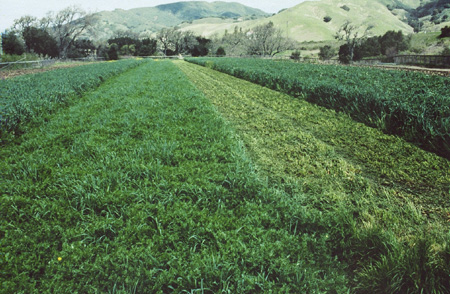Oak #1
Oak #2
Oak #3
Oak #4
Hillsides
Handful of Soil
Covercrop Growing
Mowing Covercrop
Vegetarians
Carnivores
Hover Fly Larva
Hover Fly Adults
Cilantro Flowers
Good Bug Blend
Fennel flowers
Buckwheat
Kale
Parsley
Owl House
Nesting Box
Bluebird Eggs
Baby Bluebirds
One Week
Two Weeks
Other Tactics
Let Nature Talk
|
Mowing Covercrop


In the spring, we mow 6-foot tall covercrop and till it into the soil. We now call it green manure. This organic matter awakens and feeds the billions of microorganism in the soil which then feed our plants. We also add four tons of compost per acre.
We work the soil as little as possible. We rarely use a rototiller. Rototilling destroys soil aggregates and disrupts the soil life. We loosen the soil to a depth of 18 inches by pulling a chisel plow through the soil. A chisel plow has curved shanks that resemble curved fingers, but they are 1 inch thick, 18 inches long and spaced one foot apart. Its tips (finger nails) are very sharp. We never use a mold board plow which inverts the soil burying the topsoil deep under the ground. The majority of the organisms that live in the soil live in the top few inches where there is abundant air. When buried deep, they die or go dormant.
We do use a bed shaper that rototills only the top inch of soil and only rototills the top of the bed where we need to plant the tiny seeds.
We are working with the USDA Natural Resource Conservation Service to help control soil erosion. They give us technical assistance and cost share through EQIP. We have put in buffer strips, sediment traps, and grassed waterways. Fish and Game may also help us with buffer strips and riparian plantings.
We conducted three years of trails with the UC Cooperative Extension with funding from the Organic Farming Research Foundation. We compared feathermeal, liquid fish, liquid soybean meal, pelleted chicken manure, guano and compost. We found the fertilizers cost more that the yield increase. My feeling is that our soil is so alive that adding organic fertilizers has very little immediate effect. The soil has 3% organic matter and is fed constantly with green manures, crop residues and a little compost.
Iíve also tried many experiments with mycorrhizae, humic acid, rock dust, compost tea and other stuff and found them to be of no value. In healthy soil such thing already exists.
Iíve found crop rotation to be very important. I donít have a proven rotation yet, but I skip two years before planting a crop in the same family. I have learned this the hard way.
For example: when I follow lettuce with lettuce I encourage a disease called corky root. If I rotate out of lettuce for a couple of years, the disease is greatly diminished. I once planted a field of lettuce where one half had previously been in leeks and the other half in lettuce. One half suffered from corky root, the other half did not. Iíve also seen this same effect with other split fields.
|
|
